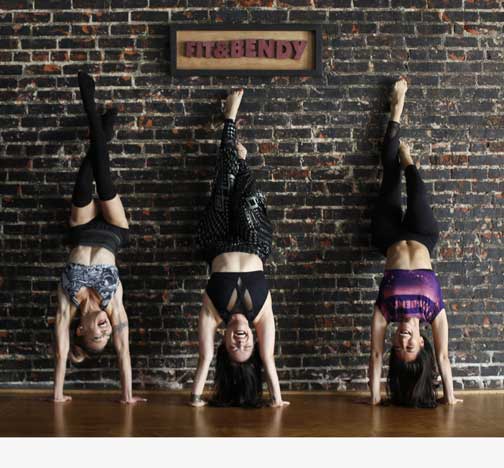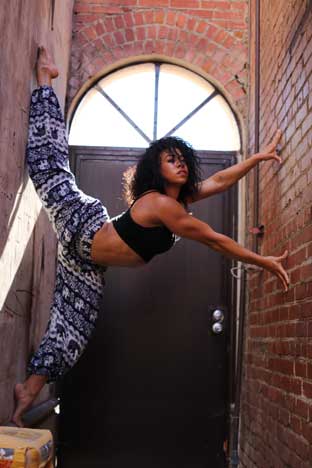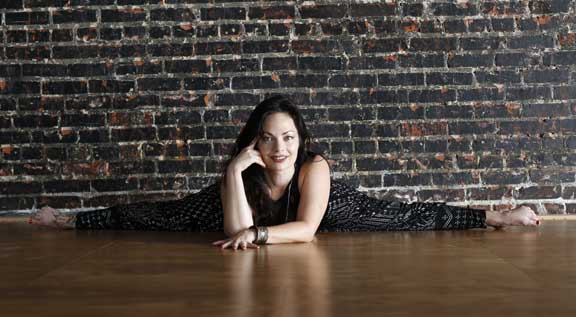Are you hunting for a new workout that is challenging but not so difficult that you can’t do it consistently? I was always on the hunt for something new and I test out a lot of workouts. Despite all the different workouts I have done (Barre, Step, HIIT, dance, stability ball, cross-country ski machines, mini-trampoline, cycling, core work, pilates {reformer and chair}, walking, kickboxing, and more), I never felt that I was very flexible. I didn’t stretch much. I have learned in the last couple of years (thanks to a frozen shoulder when I moved to a new house) that stretching and flexibility were really important. It’s much more than a few exercises and stretches at the beginning and end of a workout. I have learned some tricks to improve flexibility by using some tools (tennis balls, foam rollers, exercise bands, and loops). But if you really want to learn about the importance of flexibility, you should check out Fit & Bendy classes!
Here’s one that sounds ideal for someone seeking a balanced workout of strength and flexibility. Kristina Cañizares, the founder of Fit & Bendy has written today’s post on why flexibility is crucial to your health in the short and long run.
By the time Kristina Cañizares opened Fit & Bendy Studio last year, a community had already been forming around her unique approach to fitness and wellness. For years, Kristina had honed a new kind of methodology that goes deeper than aesthetics and weight loss, training people to build a genuinely healthy relationship with their bodies. In contrast to the high-intensity, ‘work-til-you-hurt’ mentality that dominates our collective understanding of exercise, Kristina takes a holistic, more pragmatic and healthy approach to get into shape, managing stress and maintaining wellness.
Most people understand strength and flexibility as two separate metrics of health. Some of the biggest body stereotypes in the collective are the skinny yogis who can bend into pretzels and the granite body-builders who can barely move. In Kristina’s Flexibility Fitness, she asserts that flexibility and strength are inseparable, and the entire methodology is about building them alongside each other.
Flexibility Fitness: An Anti-Aging Workout for Your Entire Body
By Kristina Cañizares
The science of fitness and its role in maintaining a healthy body is undisputed. We have become increasingly aware that regular workouts improve our lives, fueling a boom in every kind of fitness craze from Cross Fit, to Zumba, to yoga.

Shot of the class working on back & pectoral flexibility
What is fitness?
We track our steps, our heart rate, our body fat index, and our waist measurements, but none of those really measure the most important factor: how we feel. Can you have 12% body fat and be able to bench press your own body weight and still be in pain? Absolutely. It happens all the time.
The true measure of fitness is not aesthetic, it’s about your ability to enjoy your life and do the things you want to do without being in pain.
Do you want to be able to go for a hike? Play on the floor with your kids? Go out dancing? What about being able to pick up a heavy bag, reach for a glass on the top shelf, or even put on your shoes and socks without worrying that it will hurt?
This is all related to our body’s ability to move freely with strength. In other words, it depends on your flexibility.
In many fitness modalities, flexibility is treated as an afterthought. After your “real” workout you spend a few (sometimes optional) minutes absent-mindedly touching your toes and stretching your glutes. There is very little instruction as to the how or why of stretching. Even activities like dance classes and yoga that could increase your flexibility may not be specifically designed to do so. In other words, you may get more flexible from doing them if your body responds well to the types of stretches used. But you may not.
The thing is, in order to improve your flexibility you have to know why it is limited. Most people think that the biggest limiting factor in their flexibility is tight muscles, but why are the muscles tight in the first place?
For most people, muscle tightness comes from imbalances and / or chronically under-activated muscles. These imbalances happen when you have some muscles that are over-used. Meanwhile, their counterparts go un-activated, and eventually, they get pretty sleepy.
Video of Kristina Cañizares talking about shoulders in Q&A format!
A common example is the relationship between the pectoral muscles in the chest and the muscles of the upper back. Because our modern lifestyle has us sitting a lot, hunched over our devices like buzzards all day, our shoulders tend to rotate up and in. Then when we go to do our workout, or just heft our bag onto our shoulder at the end of the day, this postural bias means the body is going to have a much easier time finding those pectoral muscles than the back muscles. After a while, the pecs get so activated that they think they are in charge of everything! They start doing everybody else’s job and become chronically tight, and even painful.
Can you stretch out your chest doing a traditional arm-extended pec stretch? Absolutely! And, depending on how your particular nervous system reacts to stretching, it may even feel good and give you some temporary relief. Of course, if your nervous system doesn’t like passive stretching, it may feel like hell itself and do nothing. But either way, that passive stretch does not address the underlying imbalance, and once you are done with your stretch sesh and go back to your normal life, that pec will jump right back into its over-achieving habits and the tightness will come back.

Passive stretching is equally unsuccessful at addressing the long-term inflexibility caused by under-activated muscles.
A common example of this problem is the under-activation of the knee extensors. We have four (possibly five) quadricep muscles, and the ones that straighten our knees tend to get less love than they should in our day-to-day lives, especially at their end range of motion when the legs are all the way straight. This can lead to tight, cranky hamstrings.
In order to understand why this is we need to dip a bit into the way that muscles work with the nervous system. We think that muscles are most stressed out about lengthening, but actually what they really don’t like is shortening. The shorter a muscle gets, the more unhappy it gets, and what they really don’t like is force shortening, when someone smooshes them. This is why we generally get pain in the back of our neck from whiplash, not the front.
So what happens when we try to pull one of our legs towards our face to stretch out those hamstrings? We are force-shortening our knee extensors! And if they are not used to being shortened, this will make them nervous and grumpy. They will send a complaint to our brain, who wants to be helpful and save them from this torment. The brain will then send a message to the opposing muscle group, the hamstrings, telling them to go ahead and tighten up so that the knee muscles don’t have to suffer any further smooshing.
Of course, all of this is happening behind the scenes without your conscious mind knowing, so while you are grimly trying to stretch your hamstrings, your knee muscles are working at cross purposes and the stretch is at best ineffective, and at worst injurious if you force the issue. It will certainly be unpleasant because you are at war with your own body.
So, what does this mean for you? It means that thinking of stretching as an after-thought to your workout is restricting your ability to enjoy some of the greatest fruits of physical fitness. Flexibility and strength need to be developed together in order to preserve, and even enhance, our mobility. While this is important from the cradle to the grave, it is particularly important as we get older and the consequences of muscle imbalances and under-activated muscles start to catch up with us.
Here at Fit & Bendy, we refer to this process as End Range of Motion Strengthening, something that’s common in Physical Therapy. As a cornerstone of our Flexibility Fitness method, IT training teaches you to move your your your muscles to their flexibility limits (not the limit that makes you want to puke and cry, just the limit of where you feel some amount of stretch) and work to build strength there through small movements and light loading. Your body will learn how to be strong and comfortable in this range, which then enables the range of motion to expand. Flexibility Fitness addresses muscle imbalances by targeting all the places that you might have skipped in your regular workouts, wakes up those sleepy muscles, and teaches your body to expand its idea of what it’s capable of.
Combined with passive stretching, techniques to bring greater awareness to your fine muscle control, and nerve glides to release tension, our classes enable you to increase your freedom of movement, resulting in more mobility, less pain, and more enjoyment of your body.

Lexi showing her range of flexibility! This is one flexible woman!
Flexibility Fitness works by:
–Moving your body slightly beyond your comfortable range of motion.
–Exploring movement and isometrics that build strength in the new position.
–Building mobility and power over time, together, for functional flexibility you can use.
This allows people to build strength in muscles that are neglected by traditional training—but are important for both basic and advanced functionality. Flexibility Fitness can help you sit more comfortably at your computer chair, and (if you do the proper training) contort more comfortably and safely into that aforementioned pretzel.
“I have seen a lot of people have major transformations in what their bodies are capable of doing,” says Kristina. “Someone who couldn’t even walk half a mile was able to run a marathon. Someone who wasn’t able to play tennis can now go back to playing because their bodies are moving in a more healthy way. This type of training enables your body to do things that make it more fit. It makes you better at doing whatever it is you want to do, which leads to greater overall health.”
I see Flexibility Fitness not as a replacement for all other kinds of fitness. Your Crossfit, your yoga, your dance class or marathon are important, especially if they give you joy. But mobility is a prerequisite for doing these things safely, reducing your risk of injury and enabling you to perform better and have more fun. This is how we stay more active, more engaged, and happier over time.
If this piques your interest, I’d love to meet you! Please stop by and visit us online at www.fitandbendy.com or in person at our flagship studio in Northeast Los Angeles. We also have videos available at www.vimeo.com/fitandbendy
Happy Bendings,
Kristina “Nekyia” Cañizares
IG: @fitandbendy
About Kristina “Nekyia” Cañizares

After 6 years of working privately with clients and in small group settings at changing locations, Kristina opened the brick n’ mortar Fit & Bendy Studio perched in the foothills of Glassell Park. The studio offers more than two dozen classes each week, Monday through Sunday, and has attracted over 10 teachers, highly skilled at the Flexibility Fitness method, and bringing their own diverse specialties to the mix.
FIT & BENDY
2861 West Avenue 35, Los Angeles, CA 90065
323-379-2363 | fitandbendy.com
Thank you to Kristina Cañizares of Fit and Bendy for this very insightful piece on how fitness is much more than just strength or cardio work. That often people shortchange themselves and their bodies by not digging deep into flexibility work.
Stevie Wilson,
LA-Story.com
________________________DEALS and STEALS(Affiliate Links)
I curate deals that offer bonuses, bargains, and great products –and some are very specifically for this site to feature to my audience because I want my audience to get amazing products from great brands!
Disclosure: some of the links on this post might have affiliate links! It costs you nothing. If you buy something, the brand pays me a small percentage.
If you purchase via my link, I make a very small percentage for that purchase. It does not add any additional cost to the product. The price you see is the retail price (depending on store or vendor) .
Sunscreens Are Essential in Summer: Try COOLA Full Spectrum 360 Sun Silk Drops SPF 30

>
COOLA’s breakthrough Sun Silk Drops— your daily Full Spectrum 360° protection from the sun, environmental toxins, and digital overexposure.
Their advanced organic formula is light-as-air yet protects against broad-spectrum UVA/UVB, IR (infrared), and HEV (high energy visible) Light, meaning they’ve got you covered from beach to board meeting. A fast-absorbing complex blend of plant stem cells and patented LightWaves Defense [JS+M] technology helps to prevent visible signs of aging from both indoor and outdoor daily aggressors. Finally, full spectrum organic skincare that keeps up with your everyday modern lifestyle!
What else you need to know:
This product is formulated without oxybenzone. It is vegan, non-GMO, TSA-friendly, and cruelty-free.
Available at Sephora.com and Coola.com
Subscribe to RSS headline updates from: http://feeds.feedburner.com/la-story/Bpyd
Powered by FeedBurner
If you are going to feature content from LA-Story.com including images, podcasts or videos including the accompanying text, please respect copyright provisions. We require a notation of content origination (meaning credit tag), a link- back to the specific page & please email the link to stevie@la-story.com before the piece goes live.
LA-Story.com, LA-Story Recessionista, Celebrity Stylescope, Celebrity Style Slam Trademark/Copyright: KBP Inc./TNBT Inc 2007-22


Great and an article!
King regards,
Mead Dencker